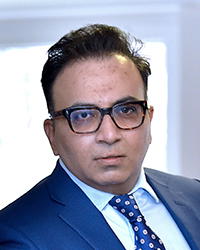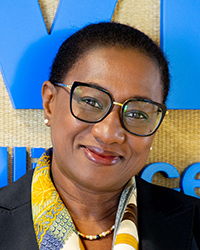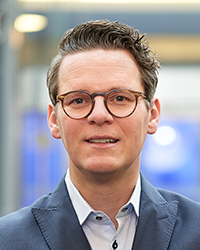

- Aniket Kulkarni
- Partner, Treasury and Commodity Trading, PwC

- Assietou Diouf
- Managing Director of Finance & Operations, Gavi

- Christian Mnich
- VP, Head of Solution Management, Treasury and Working Capital Management, SAP
Supporting Gavi’s Mission
Gavi, the Vaccine Alliance helps vaccinate children against some of the world’s deadliest diseases. Since its inception, this public-private partnership has helped immunise more than 822 million children, preventing at least 14 million deaths, in 73 lower-income countries. Gavi is currently coordinating the COVAX Facility, a global mechanism for the pooled procurement and equitable distribution of Covid-19 vaccines.
As an organisation entrusted with public funds from the international donor community, Gavi’s finance team shoulders a huge responsibility. If funds are not managed so that Gavi can carry out its immunisation work effectively, the lives of millions of children could be at risk.
For Assietou Diouf, Gavi’s Managing Director of Finance and Operations, cost efficiency is a key pillar of the organisation’s operating model. “We need to ensure that the majority of the resources are spent on equipment and delivery of vaccines,” she explains.
With increasing demands being placed on Gavi’s largely manual financial processes, in 2017 it was decided to embark upon a programme of digitisation. In 2018, the organisation selected SAP as its enterprise resource planning (ERP) system provider, and by 2019 it was live. Today it’s exploring some high-tech upgrades.
A recent TMI TreasuryCast with Diouf and Gavi’s partners, PwC and SAP, explores the project, revealing the lessons it holds for all treasuries.
Strength and control
Much of the pain of Gavi’s legacy approach was around payments, with emails, manual verification and a vast paper trail handling transaction bookings and confirmations. With time wasted on repetitive, non-value adding tasks, and siloed financial information increasingly hard to access, the team felt growth was being constrained. By 2017, change had risen to the top of the agenda.
“We had three primary objectives,” says Diouf. “We had to significantly strengthen our control environment. We needed to improve process efficiency, especially around disbursements. And we had a longer-term goal of establishing a system that would enable finance to move from a transaction-based unit to a business partner model.”
With a new and ambitious treasury blueprint in design, Gavi required technical support. The organisation selected as its partner PwC, which formed a team of dedicated project management professionals to assist Gavi in both the technical implementation and the roll-out of best practice. In addition, regular communication between SAP and Gavi served to enhance project decision-making. As Diouf notes, “it was this combination of support that led to the success of the implementation”.
Key partners
The importance of Gavi’s journey was not lost on Aniket Kulkarni, Partner responsible for Treasury Technology, PwC Switzerland. Given its role in the world, and treasury’s need to transfer donations to ground-level funding with minimum transaction cost, he could see a “big differentiator” between this and other treasury projects.
“As one of the key aspects of the overall design of the project, it was important that from a systems perspective, treasury was fully integrated into Gavi’s core processes of funds and grants management,” says Kulkarni. Working alongside SAP and Diouf and her team, PwC began laying down a digital treasury foundation. Based around the end-to-end processing and master-data repository of SAP’s S/4HANA system, it will be easier for Gavi to deploy additional applications as required, he explains.
Indeed, Diouf notes that a major selection criterion was that a high level of integration across the organisation must be possible. SAP has, she says, proven to be a game-changer. “By working with SAP and PwC, we have created a different level of integration. Not only does SAP give us a single operational portal to direct all our own core requirements, but it also acts as a hub for all of our counterparties, including our banks.”
Increasingly, treasury is getting closer to the leadership of the company, notes Christian Mnich, Head of Solution Management for Treasury and Working Capital Management, SAP. As the nexus of critical information, the function is a key component helping to steer the business. Integrated systems such as ERPs have a vital facilitating role.
“Treasurers typically deploy information from external stakeholders – such as banks and trading partners – but they also work alongside internal stakeholders in order to understand cash flow and have visibility over payments, for example,” says Mnich. “ERPs can support embedded end-to-end workflows, enabling collaboration between departments. This can be a major advantage for business users, particularly in the current atypical business environment where people are remote working.”
SAP was obviously a good fit for Gavi. Its capacity for process and workflow integration was a key influence, but the decision was also led by speed of implementation. With a range of cloud-based services on offer, accelerated implementation is possible, says Mnich.
“SAP’s scalable, highly secure cloud platform can provide additional value – because it’s a shared platform we don’t need to reinvent the wheel for each and every customer,” he explains. This means Gavi benefits from multiple connectivity options, with banks, market data providers and options for SWIFT.
The platform also uses shared infrastructure provided by a global technology player through its global data centres, all of which are regularly audited for security and regulatory compliance. “It’s a structure that helps each client to focus on their business; there’s no need to manage individual connections.”
Solid foundation
Gavi’s was truly a digital transformation project, the platform providing a stable environment for all future technologies such as application programming interfaces (APIs) and blockchain, says Kulkarni. Nonetheless, Gavi, PwC and SAP faced the kind of challenges that every transformation creates, not least change management. Gavi’s treasury consists of two FTEs managing its entire portfolio. Project work had to fit in with their daily routine. “That was a bit of a stretch for them,” he recalls, “so we worked together on project planning, supporting Gavi’s business and IT users”.
With Gavi an early adopter of SAP’s cloud-based multi-bank connectivity, PwC worked closely with the vendor to establish bank connectivity. Similarly, PwC collaborated to ensure SAP’s cloud-based market-rate management application pulled in the correct rate feeds.
The adoption of cloud applications wherever possible suited Gavi’s lean IT function, notes Kulkarni. “It was a collaborative effort to make it all work together, but I give full credit to Gavi’s on-the-ground team which managed a lot of it, with supervision and guidance from Assietou.”
Moving ahead
With faster cash disbursements, Gavi’s field programmes are swifter too, says Diouf. Simply by fulfilling Gavi’s core activities more efficiently, the digital transformation can be deemed a success. But in addition to helping treasury keep pace with new technologies, the project has also delivered a number of immediate operational enhancements.
Mindful of treasury’s lean structure, the system’s flexibility, control and ease of operation “makes a lot of difference”, she notes. One of the most appreciated and timely benefits has been its capacity to support working conditions affected by Covid-19, with Gavi able to fully operate remotely. The solution has indeed become a “powerful” part of the organisation’s business continuity and Covid-19 planning.
“In today’s world, agility is key, and cloud solutions can support that,” comments Mnich. In the case of bank connectivity, Gavi’s ERP connects once to the SAP cloud platform, giving it full flexibility and risk management without having to handle multiple connections, he explains.
In fact, within SAP S/4HANA cash management is now fully integrated, complementing its accounting and control heritage. This gives Gavi end-to-end visibility of its entire cash life cycle, spanning grant collection and funds disbursement. Cloud delivery means its compliance and internal controls are enhanced by data encryption and full client separation, with digital signing, approvals and payment traceability all fully supported. But there is more to come.
With project success requiring a “significant level of change management”, Diouf says Gavi is still “absorbing behaviours from our migration”. This has not stopped it exploring future SAP add-ons. “Extending the integration beyond the scope of finance seems to be a natural step,” she comments.
Her investigations currently cover front-end management and HR systems. In the longer term, the team “remains open to new technology”. Consideration is being given to further process automation, the ways in which artificial intelligence and predictive analytics could support forecasting, and how modelling organisation-wide real-time information can enhance decision-making.
Sharing success
“The first and the most important element of a successful project is to have the right project sponsor with the vision and leadership skills to deliver,” states Kulkarni. Gavi, he notes, had all of these facets in place. “It made for a successful project.”
For other treasurers thinking about digital transformation, he advises paying close attention to the data and the platform from the outset. “Once you have a stable platform, with all the business processes and the right data, it will be quite easy to extend that platform for all the new technologies.”
In Mnich’s view, Gavi’s digital transformation combines an established ERP system – and its provision of the most critical business, finance and treasury data – with a cloud platform that seamlessly delivers connectivity to bank partners via a single pipeline. With appropriate security levels applied, he believes that Gavi not only has “a very resilient solution” to help it through current tough times, but one that, from a general operational perspective, gives it the stability to support all relevant business processes going forward.
Reflecting upon her own project implementation, Diouf urges prospective digital treasury transformers to always seek expertise where it’s needed. Then, “from the get-go”, she believes that a structured approach to project management should be adopted, alongside a full understanding of the roles and responsibilities being undertaken by all involved.
“I know that in the not-for-profit sector, we’re perhaps seen as working with complex processes, specific to our line of work,” she comments. “But we have the same kind of digital opportunities as the private sector, and I would like to tell my peers that ‘the future is now’. Grab it and move ahead. It really makes a big difference to your staff and to your stakeholders.”
Aniket Kulkarni
Partner, PwC
Aniket Kulkarni is a Partner with PwC Switzerland and leads PwC’s Treasury and trading technology practice there. He leads a team of experts focusing on digital treasury transformation for corporate treasuries and has sucessfully completed many large international treasury transformations. Prior to joining PwC, he worked as a global product manager in treasury and commodity risk management for SAP. Kulkarni is also a Eurofinance tutor for the “Digital Treasury and Fintech” course, holds a Bachelor degree in engineering and a post graduate diploma in Finance.
Christian Mnich
VP, Head of Solution Management Treasury and Working Capital Management
Christian Mnich works in Finance Solution Management at SAP SE, based in Walldorf, Germany. Responsible for solution strategy and go-to market for the entire treasury and working capital management portfolio from SAP. He also oversees billing and revenue innovation management (BRIM) and his portfolio includes topics around payments and bank communications, cash, receivables and working capital management as well as treasury and risk management.
Mnich joined SAP in 2004 as a Product Manager for EPR Financials and had responsibility for the payments, cash management and bank connectivity. Furthermore, he oversaw developments around global payment formats such as ISO20022 and Single Euro Payments Area (SEPA). Mnich is a regular speaker at international treasury conferences and author of articles in specialist publications on a variety of treasury related topics. Before joining SAP, Christian worked as a Consultant for IDS Scheer and Bosch. He holds a diploma in business computing and computer science from the University of Applied Sciences in Berlin.



